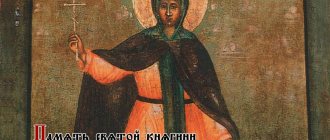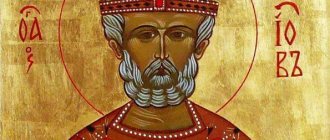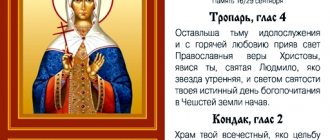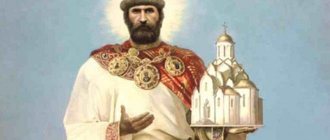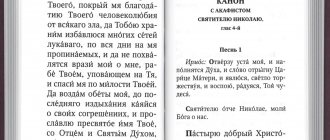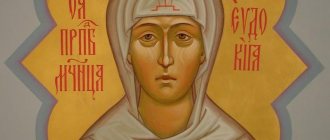| Prmts. Anastasia Romanynya. Greek icon |
Anastasia of Rome, Thessalonica, Elder
(+ 250/256), Venerable Martyr Memory June 13 (Ukr. [1]), October 12 (Greek [2]), October 29, October 30
She was born into a noble Roman family, but was orphaned at the age of three. She was taken under the protection of the abbess of the female monastic community near Rome, Sofia. In this monastery she accepted monasticism. Anastasia was 20 years old. She was very beautiful, and many noble Romans asked for her hand in marriage, but Anastasia refused everyone, preferring to remain the bride of Christ. The pagans pulled Saint Anastasia out of the monastery and brought her to the ruler of the city of Prova. They accused her of not only despising noble and rich suitors, but of considering the crucified Christ to be God.
Prov ordered her to sacrifice to idols, but Anastasia refused to renounce Christ. As punishment, she was exposed naked in front of the crowd, then tortured with fire, stretched between 4 pillars and beaten, then subjected to wheeling. Miraculously, the saint remained unharmed. The saint, bleeding, began to faint and asked for water. A certain Kirill, who was standing during her torment, took pity and gave her water to drink. The torture continued - Prov ordered Anastasia to be hung up and torn with iron hooks, then her nipples were cut off, her nails were pulled out, her teeth were knocked out, her arms and legs were cut off, and finally her tongue, with which she constantly praised God, was torn out. The people, seeing the inhumane mockery of the saint, were indignant, and the rulers of the city were forced to stop the torture by beheading the martyr with a sword. Deciding that Cyril, who gave the martyr water to drink, was a secret Christian, the torturers captured him and also executed him.
The body of Saint Anastasia was thrown outside the city to be devoured by wild animals, but God did not allow the holy remains to be mocked. Abbess Sophia, notified by the Lord, found the tortured body of the venerable martyr and, with two Christian assistants, buried it. The time of the saint’s torment is attributed to the year 250 or 256 [3].
Life of Saint Anastasia the Roman in the monastery
It is known that the Roman woman was born into a noble family of a Roman nobleman. When she was 3 years old, the girl lost her parents. The abbess of the monastic community took her under her protection. There the future martyr accepted monasticism. The girl was only 20 years old, she was famous for her beauty, there were rumors that they would soon marry her. And so it happened. Notable rich men asked for the girl's hand in marriage, but she refused everyone, proudly calling herself the bride of Christ.
One night, the future saint was kidnapped from the community. The pagans took her to Provo, the ruler of the village. He asked her why she refuses rich and noble nobles. She responded by praising Christ again. Then they began to torture Anastasia. First, they put her naked in the square, then they began to burn her with fire, stretched her veins between four pillars, and subjected her to wheeling. Anastasia steadfastly withstood all the torment. Despite this, the saint remained alive. The saint was bleeding, but was unharmed.
The only thing that bothered me was thirst. Then, between tortures, the martyr asked for water to drink. A wanderer named Kirill took pity on the girl and gave her water. Prov found out about this. He ordered the martyr to be hanged, then her nails, teeth, and hair torn out. The city's residents could no longer endure the torment. They rebelled against Prov. Then he ordered to simply cut off the holy head with a sword. Cyril, who brought the water, was considered a hidden Christian, so he was also executed.
martyrs, one of the first martyrs of Rome
To the 1950th anniversary (2018) of the time of his departure to the Lord
(+ about 68 according to the church calendar) [+ 68]*.
Memorial Day
: *
April 15
(April 28). Departure to the Lord (+ about 68) [+ 68]*.
Latin spellings of names
: Basilissa and Anastasia.
Names translated from Greek
: Vasilissa - “Royal”; Anastasia - “Resurrection”.
Main milestones in the lives of the saints:
* Time of birth
: unknown, most likely 1st century.
* Place of birth
: unknown, probably Rome, but it is possible that the Roman fortress of Setabis Augustus in Spain.
* Time of departure to the Lord
: presumably April 15 (April 28) 68 *.
* The resting place of the relics at present
: the Church of St. Mary the Pacifier (Santa Maria della Pace) in Rome.
(To the top of the page)
LIFE
Two inseparable maidens lived in powerful Rome. They loved their city, often walking with trepidation along its ancient streets. And then one day a crowd of people stood in their way. Someone told them a completely new, never-before-heard story about a real God who gave his life for the eternal bliss of people. These words of the unknown narrator were so amazing, so spiritual that Vasilisa and Anastasia were enchanted by the opening prospect of eternal life together with a God who loves people. They found an opportunity to continue listening to the witness of God’s grace, and it turned out to be none other than the Apostle Paul himself. This acquaintance happened around 67.
So gradually, imperceptibly, the innately pagan women of Rome became Christians. But the years were difficult, difficult. Emperor Nero, under whom Rome burned down during these years, found a cunning move to blame Christians for the monstrous crime. Didn't they burn it? And who could prove anything at that time, and was it necessary to do it if the emperor himself announced this atrocity publicly... And who else could be declared criminals in those days without danger to the throne? Christians, after all, obediently made any sacrifices for the sake of their Christ, and in many cases joyfully rushed to execution.
The time has come for the execution of the apostles Peter and Paul. Who do you think buried their holy remains? That's right - sisters in Christ Vasilissa and Anastasia. Having learned where the remains of the wondrous apostles were, they buried them in the dark night, hoping that no one would notice them. Subsequently, they began to regularly bury the bodies of tortured Christians. But at all times there have been disgusting creatures that look like people, and are still called informers to this day.
Vasilisa and Anastasia were imprisoned and the most difficult tests of loyalty to Christ began for new Christian souls. They bore their cross with as much honor as possible. At first they tried to persuade them to renounce our Lord Jesus Christ with the help of promises of a comfortable life, but since this did not bring any results, Vasilisa and Anastasia began to be subjected to painful torture. As sacred legend testifies, the skin of the virgins was torn off, their bodies were burned with candles and scorched with torches, and they were mercilessly beaten with whips. But even these compulsions to renounce turned out to be useless and powerless before the courage of the holy virgins.
Nero, who was informed about this story, flew into a rage and ordered the martyrs’ tongues to be immediately cut off and executed by beheading. Thus Saints Vasilisa and Anastasia entered the Kingdom of Heaven along a narrow path...
This, it would seem, is the whole story about the holy first martyrs of Rome, usual for those terrible years. But, centuries later, Spain had its own legend, explaining the path that these two holy martyrs took to Rome. According to this legend, widespread in Valencia, Vasilisa and Anastasia were sisters, born into the family of a tailor. Their childhood was spent on the streets of the Roman fortress Setabis Augusta (now the city of Xativa). In Valencia it is stated that the Apostle Paul once reached Setabis with his preaching and his fiery speech about the Savior of the world and the Kingdom of Heaven was heard and believed by two young hearts. And despite the persuasion of their relatives and friends, Vasilisa and Anastasia were baptized by the Apostle Paul, went with him to Rome and became his faithful helpers. And for us, Orthodox, they became precisely the Roman martyrs. By the way, to this day in Valencia the holy martyrs are revered as the patrons of tailors.
Holy Roman martyrs Vasilisso and Anastasia, pray to God for us!
(Back to top of page)
POWERS:
As stated above, the bulk of the relics of the holy martyrs are kept in the Church of St. Mary the Pacifier in Rome. But, in addition, a particle of the relics of the holy martyr Anastasia is in the Museum of the Cathedral of Domnina in Fidenza near Parma (see photo album here, as well as information about the Museo del Duomo di Fidenza). If you know where else you can pray before the holy relics of the Roman martyrs Vasilisa and Anastasia, then please share the information.
(Back to top of page)
VIDEO:
* Name Day program: Vasilissa and Anastasia. From Boris Korchevnikov.
* Multi-calendar. April 28.
(Back to top of page)
DOXOLOGY:
Troparion, tone 1:
The lambs of words, the Lamb and the Shepherd,/ brought by torment to Christ,/ having ended the course/ and having kept the faith,/ the same today with a joyful soul we fulfill/, venerable Vasilisso and Anastasia/, your holy memory,// magnifying Christ.
Kontakion, tone 4:
We celebrate the memory of the passion-bearers of Christ Vasilisa and Anastasia, / and by faith asking for help / to deliver everyone from all sorrow, calling: / Our God is with us, / Who glorified these as he willed.
Magnification:
We magnify you, / passion-bearers Saints Vasilisso and Anastasia, / and honor your honest sufferings, / which you naturally endured for Christ.
(Back to top of page)
INFORMATION SOURCES:
* Martyrs Vasilissa and Anastasia of Rome. Information of the Sretensky Monastery, Moscow.
* Memory of the holy martyrs Vasilisa and Anastasia. As presented by St. Demetrius of Rostov.
* Vasilissa and Anastasia.
Orthodox encyclopedia. (Back to top of page)
Icon of the Venerable Martyr Anastasia of Rome
The story of the martyr does not indicate that Anastasia was ready for torture. In fact, before the torture, an angel appeared to the girl. He asked if she was ready to suffer for Christ. What the martyr always said that she was ready for.
After his death, news of suffering and execution spread throughout Byzantium. Later icons were painted. On them, Anastasia is mainly depicted from the waist up or in full height. The saint holds a list and a cross in her hands, which speaks of fidelity to religion and the teachings of Christ.
When is the day of remembrance of the Venerable Martyr Anastasia of Rome in 2022?
Memorial Day for Anastasia Rimskaya in 2022 is celebrated on November 11.
According to the old style, the day of memory of Anastasia of Rome was celebrated on the church calendar on October 29. The date is not moving; it is celebrated by the Orthodox Church on the same day every year.
The Venerable Martyr Anastasia of Rome had a difficult worldly life with a large number of problems and hardships that haunted her. Faith in God and his help helped her cope and stay on the right path throughout her life.
Days of remembrance are an important moment in church life and ministry, as they remind us of the difficulties that Christians faced in the process of spreading the truth to the masses. Almost everyone who is canonized has their own day of remembrance, on which it is customary to give thanks for the journey they have made and ask for help in various matters.
How does the image of Saint Anastasia the Roman help?
Those who need advice and participation traditionally come to the icon. The martyr helps everyone who asks to strengthen their faith and guide them on the true path. Anastasia is remembered as the most beautiful girl in Byzantium, who did not value earthly things, but made a choice in favor of the spiritual.
Mothers who want their children to find themselves and their true faith often find themselves in front of the icon.
Prayer to the Venerable Martyr Anastasia of Rome
Services are traditionally dedicated to the saint and prayers are ordered. At home and in church, the saint is addressed with special prayers, the texts of which were written many centuries ago.
Prayer text
Praise to virgins and glory to martyrs, Reverend Anastasia! We fall to you in the tenderness of our hearts and we pray for your intercession with the Lord for us. If we are not jealous of your purity and fearless confession of yours, we do not partake of it; moreover, by our many sins and cruel falls and apostasies, we have attracted the wrath of God, but we do not want it in our sins die and, looking at your courageous exploits, we take up arms against overcoming our passions. This is the truth, since apart from grace-filled help we can do nothing good, we ask this gift from the Lord to you. For you, most glorious martyr, have gained great boldness towards the Master, for you have glorified Him in your pure soul and in your body through your suffering, having despised all the seductions and reproaches of the tormentor, having eradicated having suffered the cutting off of teeth and nails, and the cutting off of breasts and hands and feet , you boldly cried out: “Christ is my wealth and praise.” Moreover, from that wealth and our poverty, protect our spiritual life from the riches and our poverty and from immeasurable sins, obtain peace and tranquility for us, protect us from need and despondency by your intercession, protect us from each other in obedience Instruct in love and brotherly love and always lift up the eyes of our hearts to the Lord , it is always possible for us to glorify the Father and the Son and the Holy Spirit, and your warm intercession forever and ever. Amen.
Troparion to the Venerable Martyr Anastasia of Rome, tone 4
Your lamb, Jesus, Anastasia,/ calls with a great voice:/ I love You, my Bridegroom,/ and, seeking You, I suffer,/ and I crucify myself, and I bury myself in Your Baptism,/ and I suffer for You. Come, let me reign in You,/ and I die for You, and I also live with You;/ but, as a blameless sacrifice, accept me with love, sacrificed to You./ Through my prayers// as the Merciful One, save our souls.
Translation: Your Lamb, Jesus, Anastasia, cries out loudly: “I love You, my Bridegroom, and, seeking You, I suffer, and I am crucified, and I am buried with You in Your baptism, and I endure torment for You, that I may reign in You, and I die for You, so that I may live with You; but, accept me as an immaculate sacrifice, offered to You with love!” Through her intercessions, as the Merciful One, save our souls.
Kontakion to the Martyr, tone 3
Purified by the waters of virginity, O Reverend, / martyrdom with the blood, Anastasia, having been crowned, / grants healing and salvation to those in need of ailments, who come from the heart, / for Christ gives you strength os,// exuding ever-flowing grace.
Translation: Purified by the water of virginity, by the blood of martyrdom, Anastasia, crowned, you give to those in need healing of illnesses and salvation, coming from the heart, for Christ gives you strength, always flowing forth.
Reverence
| The Torment of St. Anastasia. Fresco (by Zorzis Fouca, 1547). Monastery of Dionysiates, Athos |
Since the Great Martyr Anastasia the Pattern Maker also suffered during the reign of Diocletian, and in a number of ancient hagiographic works there is no clear division of information about Anastasia the Roman and the Pattern Maker (called the Elder and the Younger, respectively), it is difficult to be sure of the identity of the relics, images and temples dedicated to them.
In a number of sources of Constantinople origin, the memory of Saint Anastasia of Rome is celebrated on October 12 [4], but in most Byzantine calendars her memory is kept under October 29 [5].
In Rus', the earliest evidence of the veneration of Anastasia the Roman is the mention of her memory on October 29 in the month books of the Archangel Gospel of 1092 [6] and the Mstislav Gospel of the late - early 12th century [7]. However, her memory on October 29 is missing in the oldest lists of the Studian-Alexievsky Typikon of 1034 [8], she appears in the lists of this charter from the 2nd half of the 14th century [9]. The service to the Venerable Martyr Anastasia of Rome was included in the Menaion at the end of the 14th century [10]. In the 1st half of the 12th century in Rus', a translation of the 1st edition of the non-stichic Prologue was carried out, in which a brief life of the saint is given under October 12, and on October 29 only her memory is indicated [11]. In the 2nd edition of the unstitched Prologue, which was formed in Rus' at the beginning of the 13th century, on October 29. instead of the life of Anastasia the Roman, there is a short life of Anastasia the Pattern Maker, and under October 30 there is the life of Anastasia of Thessalonica, which is identical in content to the life of the Roman, with the exception of indicating the place of death of the martyr [12]. In the Great Menaions of the Four under October 29, in addition to the prologue lives, a lengthy life of Anastasia the Roman [13], entitled “The Life of Anastasia of Thessaloniki” [14], is included. At the beginning of the 21st century, the calendar of the Greek Churches indicates the memory of only Anastasia the Roman on October 29, while the calendar of the Russian Orthodox Church on October 30 also marks the memory of Anastasia of Thessalonica.
Relics
| Prpmts. Anastasia the Roman, icon |
In the 1680-1681 inventory of the Annunciation Cathedral of the Moscow Kremlin, a reliquary with a particle of the relics of Anastasia the Roman is mentioned.
In 1860, Archbishop Modest (Strelbitsky) of Volyn brought to Zhitomir the gift of the Antiochian Patriarch Hierotheus - the head of St. Anastasia Roman. Upon his death, he bequeathed it to Zhitomir. Archbishop Anthony (Khrapovitsky), who took over the Volyn See, made sure that the head of the saint “appeared open to all Christians of the Volyn region.” And in 1903, with the permission of the Holy Synod, the head of St. The venerable martyr was solemnly transferred to the Zhitomir Transfiguration Cathedral. In the same year, Archbishop Anthony, fulfilling the will of the late Bishop Modest, opened the St. Anastasius Church in the basement of the cathedral - over the graves of Archbishops Modest and his predecessors Agafangel and Tikhon. It was here that the saint’s relics were placed in a luxurious cypress shrine, lined with silver. In 1935, St. Anastasius Church was closed and desecrated, and the relics mysteriously disappeared. But in 1941, when the temple was opened again, the head of the saint returned. After the war, the temple was closed again, and the relics disappeared under mysterious circumstances. In the spring of 1999, the convent of Anastasia the Roman was opened in Zhitomir [15].
Hymnography
According to different editions of the Studite Charter [16], on October 29, a service is performed for the Monk Abraham the Recluse and Anastasia the Roman, and the Evergetid Typikon indicates the service with Alleluia, and the Messinian Typicon indicates the dismissal general troparia for both saints, that is, the service for 2 saints without a sign. The first printed Slavic Typikon of 1610 and the Typikon, now used in the Russian Orthodox Church [17], also prescribe the celebration of services to 2 saints without a sign on October 29.
In the printed liturgical Greek and Slavic Menaions currently in use, the service of Anastasia of Rome is placed with the canon of Joseph in the 8th tone, already indicated in the Evergetid Typikon. The same Typikon indicates the body of stichera on the Lord I cried, placed in the Greek printed Menea and different from the stichera in the Slavic printed Menea. The general troparion to the martyr “Your Lamb Jesus,” found in the Slavic, but absent in the Greek printed Menea, is indicated in the Messinian Typikon. In the Greek printed Menea, according to the 6th canon of the Matins canon, the verse synaxarion of Anastasia of Rome is placed under October 12 and 29 [18].
